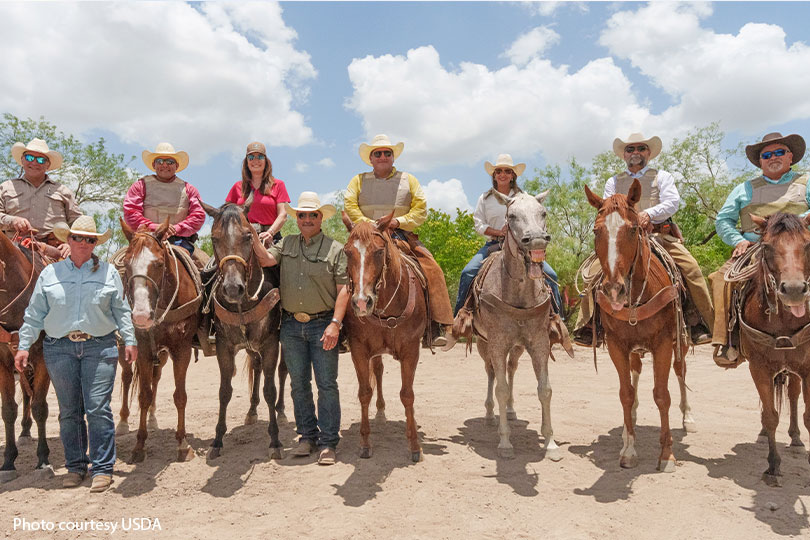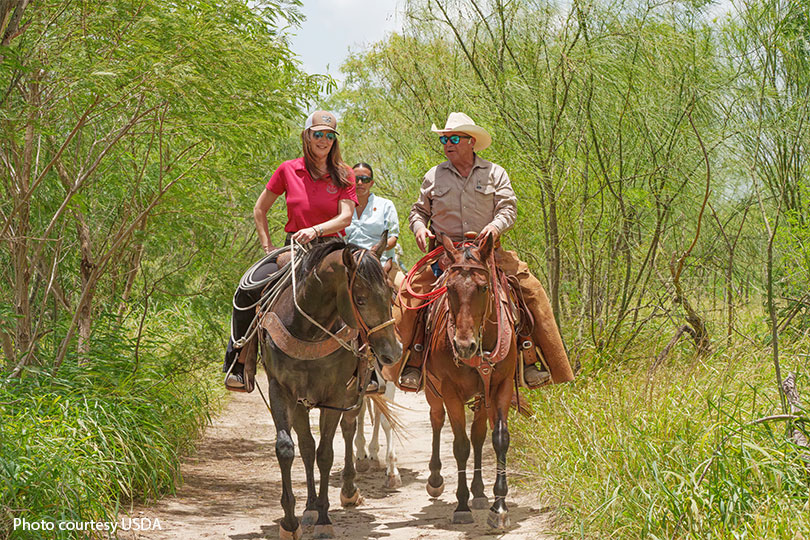By Julie Tomascik
Editor
U.S. Secretary of Agriculture Brooke Rollins saddled up for a boots-on-the-ground look at livestock protection efforts along the Texas-Mexico border during her recent visit to the Rio Grande Valley.
She rode alongside USDA’s Tick Riders near La Joya, experiencing firsthand the work being done to safeguard U.S. cattle from foreign animal pests. Riding with her was Doug Anderson, supervisor of Field Operations for USDA’s Tick Eradication Program and president of Starr-Zapata County Farm Bureau.
“For someone at her level to take time out of her day to ride with us really says a lot about her dedication to agriculture,” Anderson said. “She had just wrapped up a press conference at Moore Air Base and then jumped in a vehicle to come meet with me and my coworkers. That kind of commitment means a lot.”
Anderson has worked with the tick riders since 2005 and has served as county Farm Bureau president for nearly a decade. His team patrols the permanent quarantine zone on horseback, scanning for stray livestock and signs of cattle fever ticks—another tiny but devastating parasite that can threaten entire herds.
“Our guys are not just out trail riding,” Anderson said. “We’re vigilant, constantly scanning the landscape. We’re conducting patrols and tracking stray cattle, horses, mules, anything that could carry fever ticks and now screwworms.”
The cattle fever tick quarantine buffer zone spans about 500 miles stretching from Del Rio to Brownsville. The buffer zone helps prevent the re-establishment of fever ticks in the U.S. by stopping their northward spread.
The patrol with Rollins covered one of the routine trails in Hidalgo County. During the ride, Anderson pointed out various tracks, explaining how the tick riders use those signs to determine if animals have crossed from Mexico into Texas.
The tick riders are an important part of the USDA’s five-pronged strategy that Rollins announced during her trip to the Valley.
“One of the prongs is the surveillance along the Texas-Mexico border, and that’s done by us—the tick riders,” Anderson said. “If this pest crosses into the U.S., we’re the first line of defense. We’re already being proactive with preventive treatments. We take this work seriously because it’s not just a job. It’s our way of life.”
Rollins’ visit, Anderson said, reaffirmed the importance of their mission. It also highlighted the strong partnership between Farm Bureau leaders, federal agencies and local communities in protecting livestock and agriculture across the state.
“She’s very engaged on this New World screwworm issue,” Anderson said. “We can see her dedication to the ag community, to the farmers and ranchers and the United States battling this looming threat that’s in Mexico.”



Leave A Comment